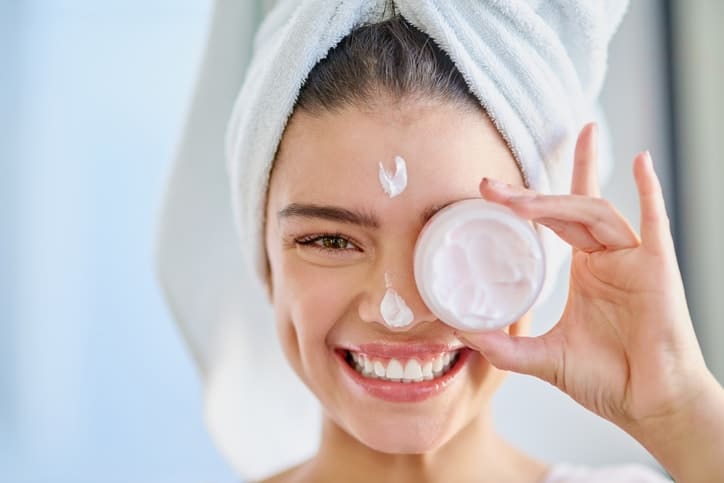
Hypochlorous acid (HOCl) might sound like something from a high school chemistry lab, but in skincare? It’s one of those underrated, “why didn’t I try this sooner?” ingredients. It’s gentle, it works on pretty much every skin type, and it plays well with almost everything in your routine.
But the real question is: when should you use it to get the most out of it?
Let’s break it down.

First, What Is Hypochlorous Acid?
HOCl is actually something your body makes naturally — your white blood cells use it to fight off bacteria and calm inflammation (Wang et al., 2021). In skincare, it’s made through a special water-electrolysis process, creating a super gentle antimicrobial mist or solution.
Think of it as your skin’s “calm down” button — soothing redness, helping breakouts heal, and keeping things clean without that tight, stripped feeling.
Why It Works So Well
-
Bacteria-fighting power
HOCl goes after acne-causing bacteria without wrecking your skin barrier (Del Rosso & Leyden, 2018). -
Calms irritation
It’s amazing for taking down redness, whether it’s from a workout, a breakout, or too much time in the sun (Draelos, 2022). -
Helps skin recover
Perfect for post-microneedling, peels, or any time your skin needs a gentle assist.
When to Use HOCl in Your Routine
Here’s where HOCl really earns a permanent spot on your shelf:
-
Right after cleansing
Spray it on clean skin to calm things down and prep for your serums.
-
Before and after workouts
A quick mist pre-gym helps keep skin clear; post-gym prevents sweat breakouts.
-
After treatments
Microneedling, extractions, peels — HOCl is your skin’s best friend for keeping irritation and bacteria under control (Draelos, 2022).
-
Midday refresh
Feeling flushed or tight from a mask or dry air? A few spritzes = instant relief.
-
On active breakouts
Mist or dab directly before your spot treatment to reduce bacteria and inflammation.

How to Layer It
-
HOCl goes after cleansing, before serums/moisturizers.
-
Totally fine with actives like retinol, vitamin C, or exfoliating acids.
-
Use morning, night, or both — it’s gentle enough for daily (even twice-daily) use.
How Quickly Will You See Results?
-
Redness relief: Sometimes within minutes.
-
Breakout calming: A few days with consistent use.
-
Post-procedure recovery: Usually 1–3 days to see less irritation and faster healing.
Is It Safe?
Yes — HOCl is one of the gentlest skincare ingredients out there.
⚠️ Still, patch test if you’re trying a new formula.
⚠️ If the product also contains other actives, make sure they’re ones your skin tolerates.
HOCl: Must-Have or Nice-to-Have?
Here’s the truth:
✅ Amazing for keeping skin calm and clear.
✅ Fits into literally any routine.
❌ Not a miracle worker — it’s more about balance and prevention than replacing your retinol.
If your skin gets easily irritated, breaks out after workouts, or just needs a “reset” step, HOCl will probably become one of those products you don’t want to be without.
Final Thoughts
HOCl isn’t flashy — but that’s its magic. It’s the skincare equivalent of a reliable friend who always shows up when you need them. Whether you use it once a day, twice a day, or just when your skin is acting up, it’s one of the easiest ways to keep your complexion happy.
Available on Amazon USA and Amazon Canada, our hypochlorous acid spray might be the next skincare item you want to add to your routine.

Wondering how you could get rid of smile lines? Check out this blog now.
Disclaimer
This article is for informational purposes only and is not medical advice. Always check with a dermatologist before trying new products, especially if you have sensitive skin, allergies, or specific skin conditions.
References
Del Rosso, J. Q., & Leyden, J. J. (2018). The role of topical hypochlorous acid in the management of skin disorders. Journal of Clinical and Aesthetic Dermatology, 11(3), 25–30.
Draelos, Z. D. (2022). Post-procedure skincare: Optimizing recovery and results. Dermatologic Surgery, 48(2), 134–140.
Wang, L., Bassiri, M., Najafi, R., et al. (2021). Hypochlorous acid as a potential wound care agent: Safety, stability, and efficacy. Journal of Burns and Wounds, 20(4), 112–120.
Written by
Honeydew Labs Team















